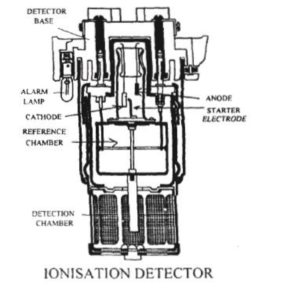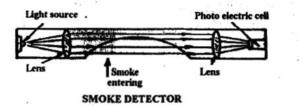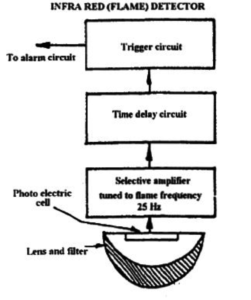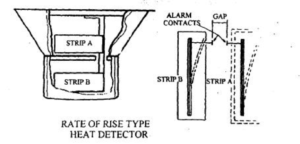Ionisation type
Used where fuel or other combustible material produces various products of combustion much before the appearance of smoke or flames. A radioactive source, such as radium, ionises the atmosphere -in both open and closed chambers. Under normal conditions, the circuit is electrically balanced. When combustion products enter the open chamber, the ion flow is retarded and the electrical resistance is increased, thus creating imbalance, which triggers the alarm. Testing is carried out by injecting a pre-filled hydro carbon gas into the detector head, by means of a special spray can provided.

Photo Electric / Smoke Detector type.
These are used where smoke is produced much before any flame is visible e.g. insulation fires. When there is no smoke in the head, the photo electric cell cannot detect the flash tube signal. The addition of smoke causes light to fall on to the P. E. cell, which triggers the alarm.

Infra-red / Flame sensor type
Used where flames could occur in hot spaces, where heat detectors would not work, such as in the machinery space cylinder head platform. The head is designed to sense radiation waves of 25 Hertz, which corresponds to that of naked flames. A time delay mechanism reduces false alarms due to light reflecting off rotating machinery or similar cause. Testing is carried out by a naked flame at 5 m distance .

Heat sensor / rate of rise sensor
These are used where there may be high ambient temperatures e.g. machinery spaces, galleys. Two bi-metallic strips are placed in parallel to form an electrical circuit. One is insulated to the atmosphere and the other. is open. A sudden increase in temperature would cause the open strip to bend quicker than the insulated one, and trigger the alarm circuit. However, gradual ambient temperature increase would-cause both strips to move equally and not trip the alarm.

